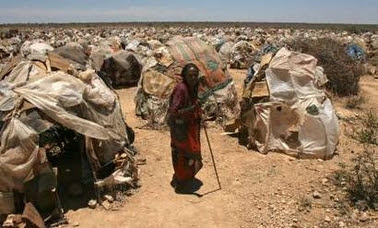SOMALIA'S REALITY......What you DIDN'T know:
- Official Name & Capital: Somali Democratic Republic and it's capital Mogadishu.
- Location: Located in Africa, Somalia is bounded to the south and east by Kenya, to the west by Ethiopia, Djibouti to the northwest, and to the east the Indian Ocean.
- Population: of 6,590,32 (1997 estimate), principal cities: Mogadishu,Hargeisa, Kismaayo, and Marka.
- Current Government: No permanent national government; transitional, parliamentary federal government.
 |
| Girls Make up a THIRD of the students. (they are the minority. |
- Education & Literacy Rates:Age 15 and over can read and write, Male: 49.7% and Female:25.8%. There are 1,172 operating SCHOOLS with a total of 285,574 children representing an 19.9% enrollment, placing Somalia among the lowest enrollment rates in the world.
- Languages: Somali(official language), English, Arabic, Italian, and Swahili which is spoken particularly in south.
 |
| Practicing their Religion ISLAM.....PRAYING! |
- Religion: Sunni Muslim 90%, and a minority of Christians(Mostly Roman Catholic).
- Birth Rates: 42.71 births/1,000 population (2011 est.)
- Death Rates: 14.87 deaths/1,000 population (2011 est.)
- Migration Rates: 11.81 migrant(s)/1,000 population (2011 est.)
- Life Expectancy: Male: 48.49 years, Female: 52.37 years.
- Ethnic Groups: Somali 85%, Bantu and other non-Somali 15% (including Arabs 30,000)
- Legal System: No national system , Shari'a and secular courts are in some localities.
- Voting Rights: 18 years of age.
- Industries: A few light industries, including sugar refining, textiles, wireless communication.
- Communications: - Telephones(100,000), Mobile Cellular(641,000), Radios(470,000), Television Broadcast Stations(2 in Mogadishu and 2 in Hargeisa), Televisions(135,000), Internet Users 89,000 and 3 Internet Services in : Mogadishu, Hargesia, and Boosaaso.
STOP WARS!
 |
| Young Boys PROUDLY Holding their RIFLES and GUNS! So Young and yet SO FULL OF VIOLENCE! |
- Military Service: Since 2005, the UN has listed the Transitional Federal Government and its allied militias to be frequent violators in recruiting CHILDREN IN THE MILITARY!
- Transnational Issues: Somalia was invaded by Ethiopian forces in January 2007. “Somaliland” provided port facilities in Berbera to Ethiopia and established commercial ties with other states. The British administrative line has little power to separate rival clans between Ethiopia’s Ogaden and southern Somalia’s Oromo region. Now Kenya helps to prevent the terrible fighting and the clan in Somalia from spreading south across the border.
- Independence: July 1, 1960
- People with HIV/AIDS: 34,000 people

 |
| So Many NECESSITIES. What a HORRIBLE Childhood Memory for these Kids |
- Natural Hazards: droughts, frequent dust storms over eastern plains in summer, and floods during rainy season.
- Environment Issues: Famine, use of contaminated water causes human health problems, deforestation, overgrazing, soil erosion, and desertification.
 |
| Somali "HOUSES", if you can CALL THEM THAT! =/ |
- Agriculture Products: cattle, sheep, goats; bananas, sorghum, corn, coconuts, rice, sugarcane, mangoes, sesame seeds, beans; fish.
- Electricity Production:240.3 million kWh (2002) source is by fossil fuel 100%
- Political State: N/A
- Unemployment Rates: N/A
- Refugees: 1.1million(2007)
 |
| SO MUCH POVERTY! |
- National Anthem: "Soomaaliyeey toosoo" (Somalia Wake Up) the lyrics speak of creating unity and an end to fighting.
-Climate: principally desert
-Terrain: mostly flat to undulating plateau rising to hills in north.
- Area: total area of Somalia is 246,200 sq mi.
- Natural resources: uranium and largely unexploited reserves of iron ore, tin, gypsum, bauxite, copper, salt, natural gas, likely oil reserve.


































